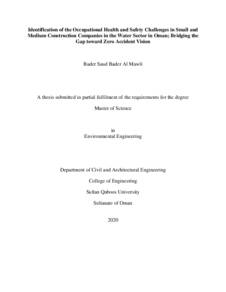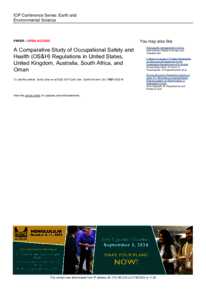Document
Identification of the occupational health and safety challenges in small and medium construction companies in the water sector in Oman : bridging the gap toward zero accident vision.
Publisher
Sultan Qaboos University.
Gregorian
2020
Language
English
English abstract
The construction sector in the Sultanate of Oman is one of the most important tributaries to the
economy of the country. Attention to all its aspects guarantees financial sustainability, and make
of it an attractive environment for work and stimulating investment. Among the most important of
these elements is the relationship between financial return and commitment to Occupational Health
and Safety (OHS) laws. The government of the Sultanate of Oman opts towards to the
enhancement and development of the small and medium companies, which adopted many
concessions and facilities that guarantee the safety and growth of this sector to be an active
contributor to build the economy of the Sultanate. However, the level of compliance to the
Occupational Health and Safety by the small and medium construction companies is limited due
to many factors such as a limited budget, the lack of understanding of the importance of
maintaining safety climate within the company, and the diversity of the culture of the construction
workers. Hence, improving such factors will contribute to lowering the construction-related
accidents.
This research focuses on the identification of challenges that limits the small and medium
construction companies' performance in adopting the best practices in the Occupational Safety and
Health. Small and medium construction working in the water sector in Oman is the context of this
study. This research investigates the adaptation and the understanding of eleven OHS dimensions
by small and medium construction companies. These are (1) individual commitment to OHS, (2)
management's commitment to OHS, (3) effectiveness of individual communication, (4)
management safety priority, (5) management ensuring safety justice, (6) management safety
empowerment, (7) learning from incidents, (8) safety climate, (9) Health, Safety, and Environment
(HSE) learning conditions, (10) safety resilience/ recovery after incidents, and (11) HSE
preventive interaction. Those dimensions are also substantial contributors toward the Zero
Accident Vision, and recommend solutions to bridge the gaps in implementing them which will
pave the way toward a Zero Accident Vision in Oman. Therefore, the second objective of this
research is defined
The research was conducted in two parts using questionnaire surveys and interviews. The
questionnaire survey method was performed to identify the dimensions, which challenge the small
and medium construction companies to improve in the OHS domain. A questionnaire survey used
in this research was adopted from the Partnership for European Research in Occupational Safety
and Health (PEROSH). The purpose of the questionnaire is to investigate the factors that contribute
V
to success in enhancing safety and avoiding accidents in construction companies. The
questionnaire survey was translated into four languages (English, Arabic, Urdu, and Hindi), and
covers eleven dimensions, and consist of 73 attributes (questions). The questionnaire was
distributed among small and medium construction companies working in the water sector. EightyEight responses were received and analyzed. The findings show that the mean results of ten
dimensions ranged between 2.43 and 2.96 out of 5 (Likert scale). Which means improvement is
required. This result was used to formulate the interview questions for the second part of the
research. The interview questions focused on the Management's commitment to OHS,
effectiveness of individual communication, management safety priority, justice and
empowerment, how organizations learn from incidents with boosting the learning platform, safety
climate, correctives and corrections plan after accidents. Two rounds of 14 interviews with a
saturation level of 85.7 % were conducted with experienced personnel working in public and
private sectors. The interviews results were analyzed and the recommendations for improvement
toward effective implementations of the 10 OHS dimensions were reported.
Member of
Resource URL
Arabic abstract
يعد قطاع البناء والإنشاءات في سلطنة عمان من أهم روافد اقتصاد البلاد، وإن الإهتمام بجميع جوانبه يضمن الإستدامة المالية، وأن يكون بيئة جذابة للعمل وتحفيز الإستثمار. ومن أهم تلك الجوانب هي العلاقة بين العائد المالي والإلتزام بقوانين الصحة والسلامة المهنية. لذا تهتم حكومة سلطنة عمان بتعزيز وتطوير الشركات الصغيرة والمتوسطة وقد اعتمدت لها العديد من الإمتيازات والتسهيالت التي تضمن سالمة ونمو هذا القطاع ليكون مساهما نشطا في بناء اقتصاد السلطنة. وبالرغم من ذلك، فإن مستوى الإمتثال للصحة والسلامة المهنية من ق بل شركات قطاع الإنشاءات الصغيرة والمتوسطة محدود بسبب العديد من العوامل مثل الميزانية المحدودة، وعدم فهم أهمية الحفاظ على مناخ السلامة، وتنوع ثقافات العمال في تلك الشركات. وبالتالي، فإن تحسين هذه العوامل سيساهم في تقليل الحوادث الناتجة من هذا القطاع. يركز هذا البحث على تحديد التحديات التي تحد من أداء الشركات الصغيرة والمتوسطة في تبني أفضل الممارسات في السلامة والصحة المهنية. وتقتصر هذه الدراسة على الشركات المتوسطة والصغيرة العاملة في قطاع المياه في عمان. كما ي قيم هذا البحث مدى تطبيق وفهم الشركات المتوسطة والصغيرة ألحد عشر ب ع دا متعلقا بالصحة والسلامة المهنية، الإ وهي )1 )الإلتزام الفردي بالصحة والسلامة المهنية، )2 )التزام الإدارة بالصحة والسلامة المهنية، )3 )فعالية الإتصال الفردي، )4 )أولوية السلامة من قبل الإدارة ، )5 )الإدارة تضمن عدالة السلامة، )6 )تمكين السلامة من قبل الإدارة، )7 )التعلم من الحوادث، )8 ) مناخ السلامة، )9 )ظروف التعلم في الصحة والسلامة والبيئة، )10 )مرونة السلامة / التعافي بعد الحوادث، و )11 ) تعتبر هذه الإبعاد أيضا مساهما كبير نحو رؤية صفر حوادث في عمان، ومن خلال ذلك تم تحديد الهدف
الثاني لهذا البحث.
والتوصية الإجراءات الوقائية في الصحة والسلامة والبيئة، و أيضا بالحلول لسد الفجوات في تنفيذها سيمهد الطريق نحو رؤية صفر حوادث في عمان، ومن خلال ذلك تم تحديد الهدف الثاني لهذا البحث. تم إجراء البحث على مرحلتين باستخدام طريقة جمع عينات استطلاعية ومقابلات شخصية. تم تنفيذ المسح )الإستبيان( لتحديد الإبعاد التي تقيس جاهزية الشركات المتوسطة والصغيرة لتحسين مجال الصحة والسلامة المهنية. علما بأنه تم اعتماد الإستبيان المستخدم في هذا البحث من منظمة الشراكة من أجل البحث الإوروبي في السلامة والصحة المهنية (PEROSH،( وإن الغرض من الإستبيان هو التحقق من العوامل التي تسهم في إنجاح وتعزيز السلامة وتجنب الحوادث في شركات قطاع الإنشاءات. وتمت ترجمة الإستبيان إلى أربع لغات )الإنجليزية والعربية والأردية والهندية(، ويغطي أحد عشر بعدا وله 73 سمة )أسئلة(. تم توزيع الإستبيان على شركات المقاوالت الصغيرة والمتوسطة العاملة في قطاع المياه، وتم الحصول على 88 إجابة وتحليلها. أظهرت النتائج أن متوسط النتائج لعشرة أبعاد تراوحت بين 43.2 إلى 96.2 من أصل 5( مقياس ليكرت(. مما يعني أن هناك حاجة للتحسين. تم استخدام هذه النتيجة لصياغة أسئلة المقابلة للجزء الثاني من البحث. ركزت أسئلة المقابلة على التزام الإدارة تجاه الصحة والسلامة المهنية، وفعالية التواصل الفردي، وأولوية السلامة من ق بل الإدارة، والعدالة والتمكين، وكيف تتعلم تلك الشركات من الحوادث من خالل تعزيز منصة التعلم، ومناخ الإمان، والإجراءات التصحيحية بعد الحوادث. تم إجراء جولتين من 14 مقابلة بمستوى تشبع وصل إلى 7.85 ٪من الردود مع أشخاص ذوي خبرة يعملون في القطاعين العام والخاص في السلطنة. تم تحليل نتائج المقابلات وصياغة توصيات التحسين نحو التنفيذ الفعال لأبعاد الصحة والسلامة المهنية العشرة.
الثاني لهذا البحث.
والتوصية الإجراءات الوقائية في الصحة والسلامة والبيئة، و أيضا بالحلول لسد الفجوات في تنفيذها سيمهد الطريق نحو رؤية صفر حوادث في عمان، ومن خلال ذلك تم تحديد الهدف الثاني لهذا البحث. تم إجراء البحث على مرحلتين باستخدام طريقة جمع عينات استطلاعية ومقابلات شخصية. تم تنفيذ المسح )الإستبيان( لتحديد الإبعاد التي تقيس جاهزية الشركات المتوسطة والصغيرة لتحسين مجال الصحة والسلامة المهنية. علما بأنه تم اعتماد الإستبيان المستخدم في هذا البحث من منظمة الشراكة من أجل البحث الإوروبي في السلامة والصحة المهنية (PEROSH،( وإن الغرض من الإستبيان هو التحقق من العوامل التي تسهم في إنجاح وتعزيز السلامة وتجنب الحوادث في شركات قطاع الإنشاءات. وتمت ترجمة الإستبيان إلى أربع لغات )الإنجليزية والعربية والأردية والهندية(، ويغطي أحد عشر بعدا وله 73 سمة )أسئلة(. تم توزيع الإستبيان على شركات المقاوالت الصغيرة والمتوسطة العاملة في قطاع المياه، وتم الحصول على 88 إجابة وتحليلها. أظهرت النتائج أن متوسط النتائج لعشرة أبعاد تراوحت بين 43.2 إلى 96.2 من أصل 5( مقياس ليكرت(. مما يعني أن هناك حاجة للتحسين. تم استخدام هذه النتيجة لصياغة أسئلة المقابلة للجزء الثاني من البحث. ركزت أسئلة المقابلة على التزام الإدارة تجاه الصحة والسلامة المهنية، وفعالية التواصل الفردي، وأولوية السلامة من ق بل الإدارة، والعدالة والتمكين، وكيف تتعلم تلك الشركات من الحوادث من خالل تعزيز منصة التعلم، ومناخ الإمان، والإجراءات التصحيحية بعد الحوادث. تم إجراء جولتين من 14 مقابلة بمستوى تشبع وصل إلى 7.85 ٪من الردود مع أشخاص ذوي خبرة يعملون في القطاعين العام والخاص في السلطنة. تم تحليل نتائج المقابلات وصياغة توصيات التحسين نحو التنفيذ الفعال لأبعاد الصحة والسلامة المهنية العشرة.
Category
Theses and Dissertations


